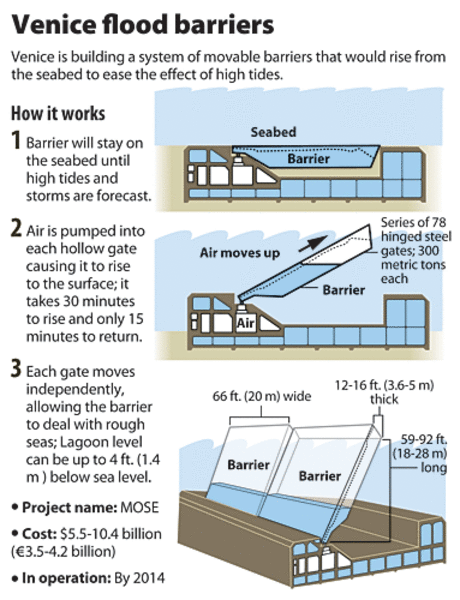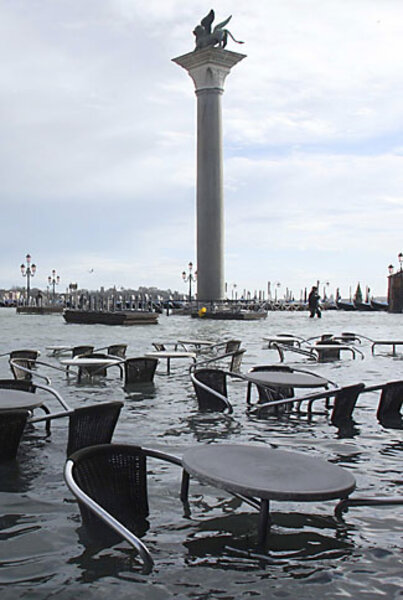Venice floodgate plan: boon or boondoggle?
Loading...
| Venice, Italy
As Venice prepares to host its famous carnival next month, the lagoon city's inhabitants have more than masked balls and black-tie parties on their minds.
The architectural gem known historically as La Serenissima – the Most Serene – is slowly slipping beneath the waves.
Rising sea levels and subsidence, resulting from decades of groundwater extraction for agriculture and industry on the Italian mainland, have caused Venice to sink 23 centimeters in the past century. Its Renaissance palaces, historic churches, and stone bridges are now menaced by floods more than 50 times a year.
Last month, the worst flooding in 22 years caused the lagoon to rise more than 5 feet above normal, forcing tourists to bunker down in hotels and shopkeepers to put up sandbag barricades. One wakeboarder streaked across the waters that swamped St. Mark's Square.
It also rekindled controversy over a multimillion-dollar scheme to save Venice's art and architecture. Known as Project Moses, it entails the construction of 78 giant steel gates across the three inlets through which water from the Adriatic flows into Venice's lagoon.
The hinged panels, 92-feet wide and 65-feet high, will be fixed to concrete bases being dug into the sea bed. When a dangerously high tide is predicted, compressed air will be pumped into the hollow panels, forcing them to rise on their hinges, forming a barrier to the waves.
Project Moses is both an allusion to Moses parting the waves of the Red Sea and a neat acronym for the project's name, Modulo Sperimentale Elettromeccanico.
It was inaugurated by Prime Minister Silvio Berlusconi in 2003 and is now expected to be operational in 2014.
But it has been dogged by political feuding, environmental concerns, accusations of political cronyism, and unease over its price tag: $4.5 billion, with estimated annual maintenance costs of $11.5 million.
The consortium building the barrier, Consorzio Venezia Nuova, insists that it will guarantee Venice's future, no matter how high sea levels rise. "Moses will solve the problem that Venice has faced for 1,000 years or more – the threat of flooding," said consortium spokeswoman Elena Zambardi, in her frescoed office in a 14th-century palazzo near the Grand Canal. "It will be capable of protecting Venice from a high tide of up to three meters, so if it had been up and running in December, the city would not have been under water."
Engineers are also reinforcing the 28-mile long, crescent-shaped sliver of land that protects Venice's lagoon.
"After many years of investigation and research, it seems to be the best option," said Lady Frances Clarke, president of the British-based Venice in Peril Fund, which was founded after the city's worst flood, in 1966, when a 7-foot high tide devastated monuments and art.
But many Venetians are not yet ready to toss their Wellington boots and waders.
"I don't think it will work – you can't tame the sea. And it's far too expensive," said Maria, a cafe manager near the famous Rialto bridge.
Environmentalists fear it will turn the lagoon, one of Europe's most important wetland areas, into a giant stagnant pond and destroy breeding grounds for birds.
Venice Council, led by left-wing mayor Massimo Cacciari, condemns the exercise as political cronyism, noting that the project was given to the consortium without being put out to tender.
"This is a way of funneling a huge amount of money to business allies of the government," said a city official, on condition of anonymity. "There are better alternatives, but they were never considered. There is a big question mark over whether it will really work."
But others accuse the City Council of simply being jealous of the millions of euros Rome is pouring into Moses.
The lagoon that surrounds Venice long guaranteed its safety from invaders – when a threat materialized, Venetians would pull up the buoys marking navigable channels, leaving their enemies floundering in a bewildering maze of sandbanks, mud flats and treacherous shoals.
But with global warming causing sea levels to rise, the water that was once Venice's protector has become its nemesis.
The success of the scheme is being keenly followed by coastal-defense experts as far afield as Russia, the Netherlands, and Britain, Ms. Zambardi says. "The scientific community is very keen to learn of our experiences and to exchange information. This is important not just for Venice, but for Italy and the world."







